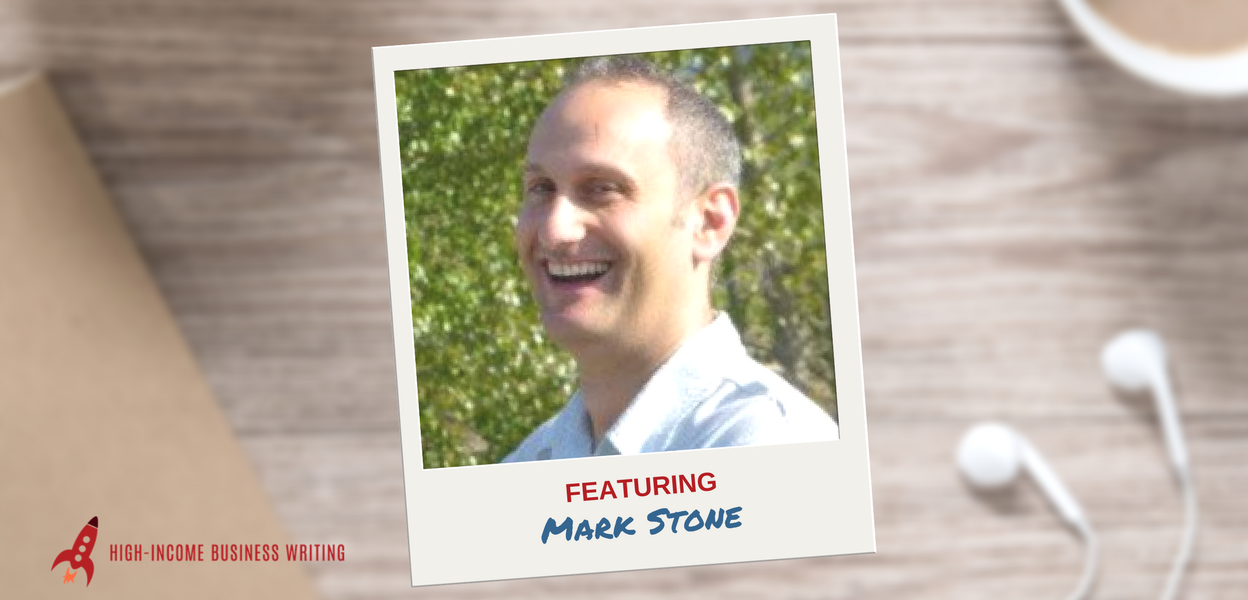One of the things that I’ve tried to be very mindful of is painting a very realistic picture of what it’s like to launch and grow a freelance writing and copywriting business today.
In fact, I take great pride in being transparent about the hard work required. You’ll hear that in most of my interviews, as well as in shows such as:
- The Rock Star Myth
- Am I a Credible Source of Freelancing Advice?
- Should You Quit, or Should You Stick?
- How I Took My Writing Biz to the Six-Figure Level (Pt. 1 of 2)
- How I Took My Writing Biz to the Six-Figure Level (Pt. 2 of 2)
Today is no exception. My guest is Mark Stone, a freelance writer from British Columbia, Canada. Mark is still in the early stages of growing his business, and he has an interesting story to tell about finding his way through this business.
You’re not going to hear a talk about rainbows and sunshine. Instead, you’ll get more of a status report from Mark. You’ll hear how Mark is landing progressively better and higher-paying clients. And how he’s pushing past fears and insecurities to improve his business and his income.
If you’re just starting out or are in the first two or three years of your freelance venture, I think you’ll get a lot out of this interview.
The notes that follow are a very basic, unedited summary of the show. There’s a lot more detail in the audio version. You can listen to the show using the audio player below. Or you can subscribe in iTunes or on Stitcher to get this show delivered straight to the Podcasts app on your smart phone, tablet or iPod.


High-Income Business Writing with Ed Gandia
#073: The Messy Road to Better-Paying Clients
Tell us about yourself
Mark Stone lives in Kelowna, British Columbia, Canada. He used to work for the Province of Manitoba, in IT security.
About 10 years ago, he left the government to start his own computer security company. To promote his business, he wrote a column for a local news website. It became popular, and a local newspaper picked it up.
Mark discovered he really enjoyed writing. He wrote a fiction novel and a few screenplays. He started writing celebrity gossip on a freelance basis. Eventually he became content director for a news website. But he knew the corporate world wasn’t for him, so he returned to freelancing.
Today, he does B2B and B2C copywriting and some public relations work. He also continues to write tech pieces.
You have a story about working with difficult clients. Can you tell us what happened?
At the end of last summer, Mark put together a proposal to provide a local company with copy and PR. He had met the CEO before and liked what she was doing. Kelowna has a lot of tech startups and this was one of them.
He started working with them. At first, everything was great. The team was good. The revenue potential was endless. Mark was billing them about 20 hours a week.
But then, every two weeks or so, a red flag would pop up. The CEO was amazing but sometimes difficult to work for. Everything he wrote was heavily scrutinized. Things he could do in an hour for other companies would take him five or more hours. The billing was good, but it was very stressful.
After about two or three months, Mark terminated the contract.
What was the tipping point?
They were putting together a big PR piece, and Mark was working on it with the VP of Sales. No matter what Mark proposed, the VP of Sales would shoot it down. The VP was also always out of town so they couldn’t meet face to face to discuss.
Eventually, Mark let them know he wasn’t the right person for the job.
What have been the biggest lessons from that experience?
1. Change your mindset. Think beyond big payments and high profile clients. Look for clients that value content and have the budget to put behind it. Don’t think of yourself as a person with a business. Think of yourself as a business, with all your morals, ethics and wisdom behind it. Often, simply switching your mindset will attract new opportunities to you. The Miracle Morning by Hal Elrod helped Mark make this switch.
2. Uncover red flags. Ask questions before accepting an assignment. What are the client’s expectations? Do they view this project as a silver bullet? Set boundaries and ground rules before you engage.
3. Don’t underestimate the value of certifications. Mark didn’t put much stock in diplomas or certifications. But he recently completed Hubspot Inbound Certification and added the certification badge to his email signature. His email response rate improved significantly.
4. Keep a big picture focus. While working for his difficult client, Mark stopped contributing to Techvibes (Canada’s most prominent tech news website). Although the pay per post is low, the exposure and authority it gives is invaluable.Don’t evaluate opportunities solely on the basis of pay. Look at the big picture.
5. Keep working your contacts. Your contacts are easy to neglect. When you send follow up emails, focus on the person you’re sending them to, not yourself. Putting yourself in the place of that person helps make your message authentic and sincere, not self-serving.
Tell us where you think you’re heading right now
After a slow-ish February, March is looking good. Mark’s goal is to have his best year ever and hopefully join the Ed Gandia six-figure income group soon!
Where can listeners learn more about you?
Mark’s website: mrmarkstone.com
Twitter handle: @mrmarkstone





